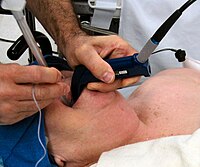
Photo from wikipedia
BackgroundWe performed a systematic review of randomized controlled studies evaluating any drug, technique or device aimed at improving the success rate or safety of tracheal intubation in the critically ill.MethodsWe… Click to show full abstract
BackgroundWe performed a systematic review of randomized controlled studies evaluating any drug, technique or device aimed at improving the success rate or safety of tracheal intubation in the critically ill.MethodsWe searched PubMed, BioMed Central, Embase and the Cochrane Central Register of Clinical Trials and references of retrieved articles. Finally, pertinent reviews were also scanned to detect further studies until May 2017. The following inclusion criteria were considered: tracheal intubation in adult critically ill patients; randomized controlled trial; study performed in Intensive Care Unit, Emergency Department or ordinary ward; and work published in the last 20 years. Exclusion criteria were pre-hospital or operating theatre settings and simulation-based studies. Two investigators selected studies for the final analysis. Extracted data included first author, publication year, characteristics of patients and clinical settings, intervention details, comparators and relevant outcomes. The risk of bias was assessed with the Cochrane Collaboration’s Risk of Bias tool.ResultsWe identified 22 trials on use of a pre-procedure check-list (1 study), pre-oxygenation or apneic oxygenation (6 studies), sedatives (3 studies), neuromuscular blocking agents (1 study), patient positioning (1 study), video laryngoscopy (9 studies), and post-intubation lung recruitment (1 study). Pre-oxygenation with non-invasive ventilation (NIV) and/or high-flow nasal cannula (HFNC) showed a possible beneficial role. Post-intubation recruitment improved oxygenation, while ramped position increased the number of intubation attempts and thiopental had negative hemodynamic effects. No effect was found for use of a checklist, apneic oxygenation (on oxygenation and hemodynamics), videolaryngoscopy (on number and length of intubation attempts), sedatives and neuromuscular blockers (on hemodynamics). Finally, videolaryngoscopy was associated with severe adverse effects in multiple trials.ConclusionsThe limited available evidence supports a beneficial role of pre-oxygenation with NIV and HFNC before intubation of critically ill patients. Recruitment maneuvers may increase post-intubation oxygenation. Ramped position increased the number of intubation attempts; thiopental had negative hemodynamic effects and videolaryngoscopy might favor adverse events.
Journal Title: Critical Care
Year Published: 2018
Link to full text (if available)
Share on Social Media: Sign Up to like & get
recommendations!